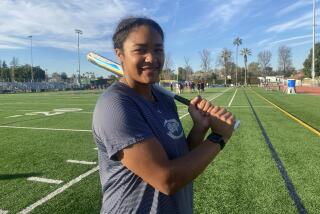League Brings Collegiate Talent to Summer Stage
- Share via
SAN DIEGO — Between checking radar guns and stop watches, scouts swapped stories. Rival fans waged a raucous but good-natured war of words. And three children played eenie-meenie-minie-moe with their nearly empty soft drink cups.
A hot and humid Monday evening at San Diego State’s Smith Field turned a bit chilly around 10, but it didn’t seem to bother many.
Nothing, least of all distractions in the stands, seemed to bother the players. They were engaged in a humdinger of a game in the San Diego Collegiate Baseball League (SDCBL).
The Angels, the dominant team for the past three seasons, needed a victory to clinch a spot in the three-game championship series. The Aztecs, winners of five in a row, needed one more to force a one-game playoff against the Angels.
So what happened?
The scouts--five or six of them, anyway--left early, perhaps with some new insights or inklings. The fans’ banter continued until the final out. And the kids dropped the eenie-meenie-minie-moe routine in favor of climbing and re-climbing the bleachers.
And the Angels pulled out a spirited, come-from-behind victory with three runs in the final inning to earn a berth in the championship series.
The setting was the final regular-season game in the SDCBL. But depending on your perspective, this was either work (for the scouts), entertainment (for the fans), mischief (for the kids) or opportunity (for the players).
One of only eight summer leagues sanctioned by the NCAA and financed by Major League Baseball, the SDCBL provides all of those. But mostly, the SDCBL is about opportunity.
Here, a player can try a new position, a new pitch or a new swing--or refine old ones, away from the pressures of his regular college season. He can get noticed, by either professional scouts or college coaches. Or he can play simply for the love of the game.
Said Alan Caldwell, the Yankees’ coach: “It gives them (players) a showcase.”
Take Angel teammates David Young and Ron Kelly, for example. They are as different as their respective right- and left-handed batting stances.
Young is a slow-talking, fairly unassuming young man--just the way you would picture a guy from Alpine, Texas (population 5,500). Teammates call him Tex, of course.
Kelly is a fiery type from Mt. Carmel High. For a personality and physical reference, teammates call him Dykstra--as in Lenny.
Kelly, who played at Palomar College and is headed to SDSU, had a chance to play in the prestigious Alaskan Summer League with SDSU Coach Jim Dietz, but opted for the SDCBL because it was in San Diego and he wanted to take some summer school classes. He was a known commodity.
Young had to beg his way in. His father, who had moved here from Texas two years ago, had heard about the league and wanted his son to get some exposure. David Young played this past season at Sul Ross State University in western Texas.
Said Angel Coach John Verdusco, “(Young’s father) called me every week for a year to tell me how well he’s doing. Now I’m expecting a 5-10, 160-pound kid with good defensive skills. But here comes this 6-1, 190-pound kid hitting home runs, and doubles, and .460. He has just been a pleasant surprise. He’s got it all. He’s got everything needed to be a pro player.”
Despite their differences, Young and Kelly have uncannily similar stats.
As of last week, both were hitting .456, second in the league by .006 and on pace to challenge the league record of .457 set by former Helix High player Joe Salmon in 1985.
Young held a slight advantage in on-base percentage (.565-.563, second and third in the league), slugging percentage (.750-.684, third and fourth) and runs batted in (23-21, second and third). Kelly led Young in stolen bases (eight-one).
In Monday’s game, Young had two hits and Kelly three, including big ones for each in the final-inning comeback. With two outs and the bases loaded, Young singled sharply in the hole between short and third to drive in one run. Kelly then doubled to right to drive in the tying and winning runs.
Kelly, one of six Angels selected for an all-star game Sunday against a team from Orange County, was that game’s most valuable player, going three-for-three with two RBIs in SDCBL’s 4-2 victory. Young is a strong candidate for league MVP honors, though Kelly and Angels Deron Thornton (University City, Mesa College), Joe Brownholtz (Mt. Carmel, Pacific) and Jimmy Thomas (Mission Bay, Mesa) might also gather support.
Get the feeling the Angels have a powerhouse team? They led the league in winning percentage (23-5-1) and batting average (.323) and were second in pitching (2.91 earned run average).
Matt Haar, the Aztecs’ coach who played in the Alaskan League a few years ago during his career at SDSU, said the Angels would be competitive in that league.
The SDCBL, on the whole, is not as strong as the Alaskan or Cape Cod leagues, but the SDCBL is relatively new, having just completed its sixth season.
It receives $30,000 each summer from Major League Baseball under the auspices of the NCAA to conduct a competitive league that supplies the Major League Scouting Bureau with weekly statistics.
In 1989 alone, 17 former SDCBL players were signed to professional contracts. None has made it to the big leagues yet, but several are knocking at the door in Triple A.
Maybe the league can take only take minimal credit for this. But then again, there is Young. A virtual unknown from a tiny town in west Texas, Young won’t be going back to Sul Ross State this fall. He has received a scholarship from U.S. International, compliments of a summer well spent.
More to Read
Go beyond the scoreboard
Get the latest on L.A.'s teams in the daily Sports Report newsletter.
You may occasionally receive promotional content from the Los Angeles Times.






